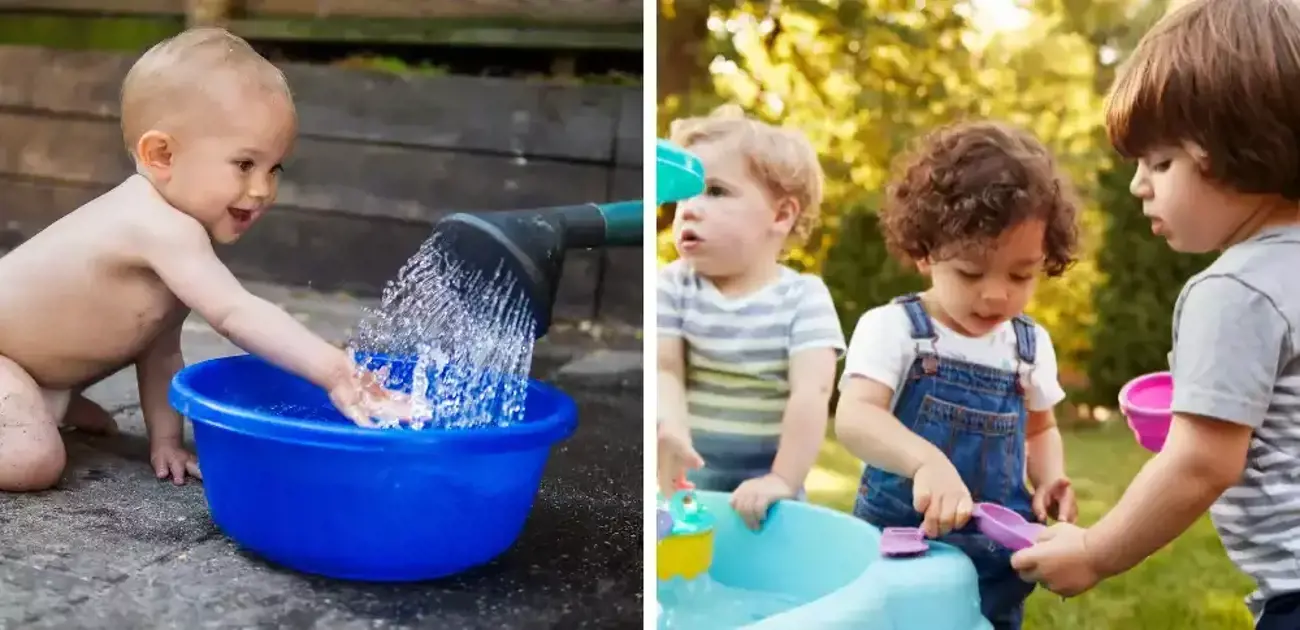The benefits of water play + bucketloads of activities to try
Water play provides oodles of fun for children, and it’s a splishy, splashy, sploshy way for under fives to learn through play.
A simple water tub provides endless opportunities for your child to observe, experiment, discover and feel. There is pouring, squirting, sponging, bobbing, sieving, melting, swishing and lots more to do, and even though we think of water play as a summery, outdoors activity, it’s easy to set up water play activities indoors and all year round.
We look at the benefits of water play in your child’s early years and provide some easy ideas for water-based activities.
How does water play benefit under-fives?
Whether your baby is patting bath bubbles, your toddler is fishing for toys or your preschooler is painting with ice cubes, water play is a great way to hone your child’s physical, cognitive and socio-emotional skills.
Single children, siblings and groups can all engage in water play, and this type of open-ended learning can help your child:
- Learn to lift, pour and control water, e.g. when they fill and empty measuring cups
- Learn to concentrate and problem-solve, e.g. when they work out how to make a toy boat sink and then float
- Understand volume, measuring and estimating, e.g. when they fit one teapot of water into three cups
- Understand the concepts of empty/full, heavy/light, float/sink and shallow/deep
- Develop hand-eye coordination, e.g. when they pour water from a jug into a waterwheel
- Develop language skills, e.g. when they learn words like ‘sieve’ and ‘whirlpool’
- Build fine and gross motor skills, e.g. when your child squeezes an eye dropper or runs through a sprinkler, and
- Learn to share and cooperate with others, e.g. when they take turns using a funnel or work together to create an underwater world in a sensory bin.
Water play is a fantastic sensory activity that can be woven into art projects and science experiments, and it also encourages pretend play (e.g. when your little one washes dishes in their ‘restaurant’, opens a perfume factory or pretends to be an ocean animal rescuer).
With simple equipment and grown-up supervision, your child can take their water play in the direction that interests them. Different ages can enjoy the same activity in different ways. And, all in all, water play is fun, flexible, educational and cheap!
Don't worry, it's easy to set up!
Although there’s the option of filling a paddling pool with pom poms or building a kiddie car wash, a water play station doesn’t need to be large-scale or laborious. You can simply fill up the bath or put a plastic container on the back deck, and if you have to move the tub inside, then a plastic sheet underneath will contain to mess to a single 'spill zone.'
When it’s time to add playthings to the water, you can look for equipment around the house, collect materials from outside, or browse the shops for interesting and inexpensive items.
Your child will have fun with:
- Measuring cups, spoons, whisks, plastic bottles, colanders, sieves and funnels
- Sponges, waterwheels, watering cans and squeezy bottles
- Water-safe plastic, wood or metal items, e.g. bath toys, foam shapes, wooden blocks and toy cars
- Natural items, like driftwood, shells, corks and small stones, and
- Soap or detergent to make bubbles.
You can create a water play sensory bin on a theme that interests your child, like dinosaurs or mermaids; add an educational dimension with floating alphabet letters, or just let your child relax into scooping and pouring.
Some parents add flowers or slices of lemon to a tub of water, and you can also:
- Make coloured bubble foam
- Mix some ice cube ‘soup’
- Fill a sensory bin with water beads, funnels, cups and scoops, or make a baby-safe water bead sensory bag
- Set up a tea pouring station, using cold water and a children’s tea set
- Scoop DUPLO bricks with a small sieve or make a fishing game for older preschoolers
- Freeze animal figurines in ice, then excavate them
- Wash dolls and clean toy cars
- Paint a window with water and stick on foam shapes
- Balance small toys on sponges or avocado shell ‘boats’
- Build a water play wall
- Play with erupting ice chalk
- Experiment with different coloured water, using non-staining food colouring
- Set up a water displacement experiment, and so much more!
Water play safety
It’s important to remember that water play does come with a level of risk. A young child can drown in just 5cm of water, so adult supervision is vital, and it’s also important that your child is protected from the sun if outdoors, and doesn’t get a chill in the cooler months.
You can move water play activities inside, and add warm water, if the temperature drops.
Saying that, now is a great time to dip your toe into this kind of play and get creative with H2O. Fill ’er up, and let the fun begin!


































